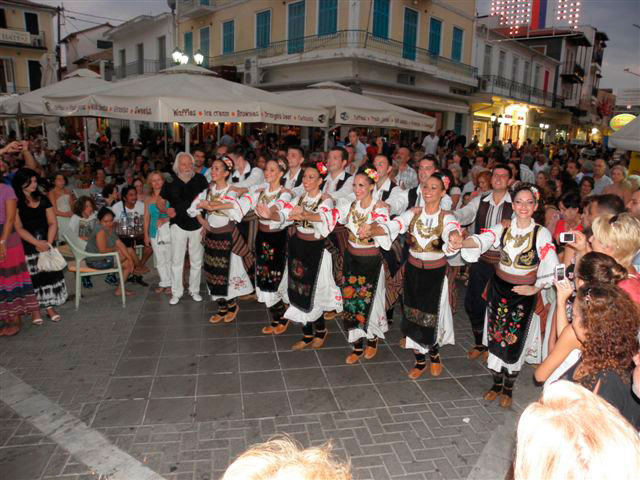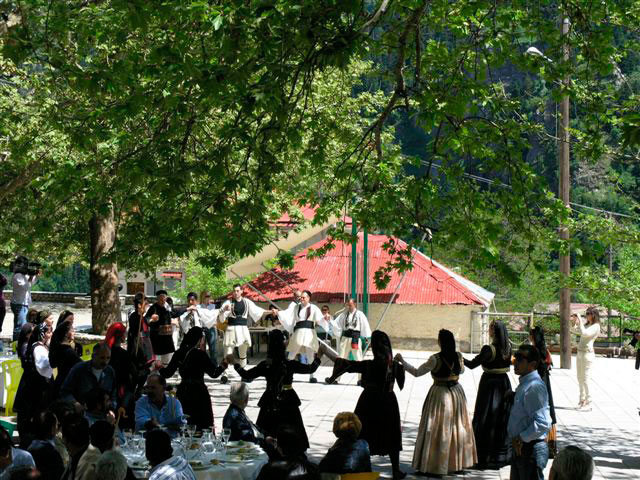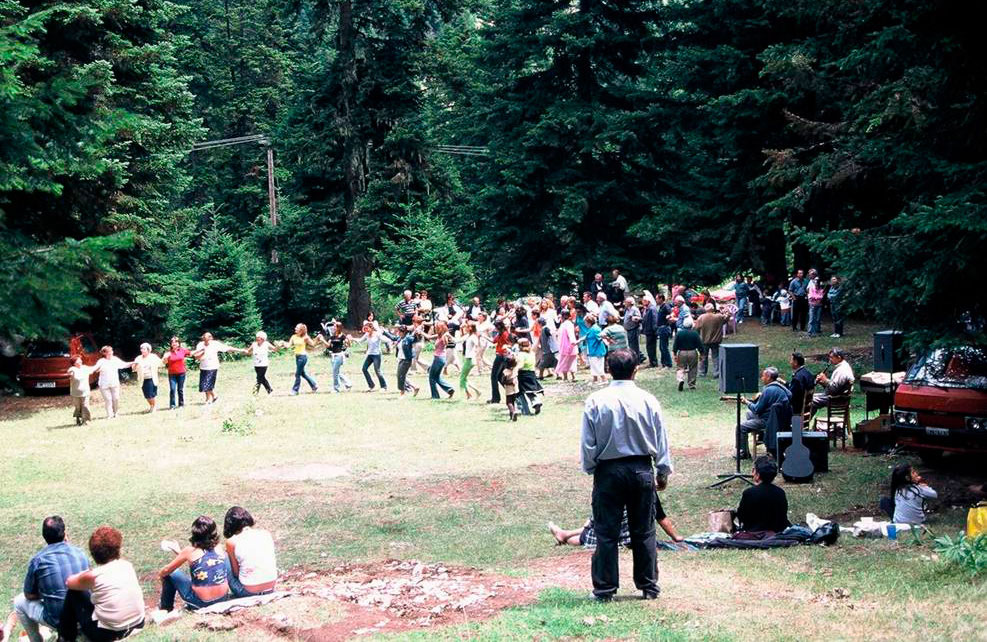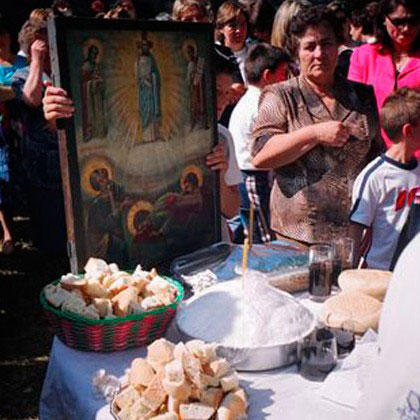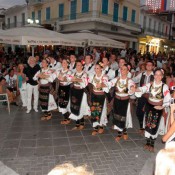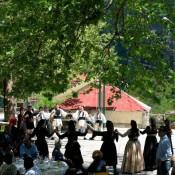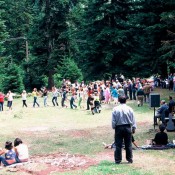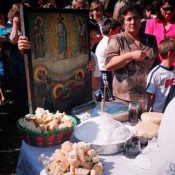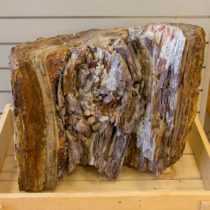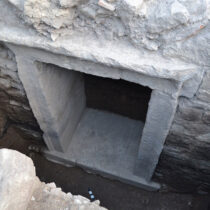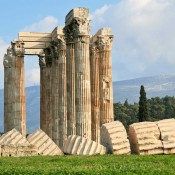It is a well known fact that according to popular mentality, the passage of time is to be experienced, determined, that is, by work done at different times of year, always in the context of a local society’s interaction with the natural environment, climate and nature of local economy. Summer, a season of plenty for the frugal Greek traditional rural society (thanks to the harvest of fruit and grain as well as the completion of the annual production of dairy products), is associated mainly with feasts, festivities and fairs. The feast day οf Ai Yiannis Liotropios (St John of the sunflower), also known as Fanistis, Rizikaris, or Kledonas is followed by a long series of celebrations/feasts and festivals all over Greece.
The feast of St John (the birth of John the Baptist on June 24th) coincides with the summer solstice which will be followed by gradually shorter days through the September equinox up to the start of the twelve days in December when we have the longest nights of the annual cycle. As a feast of transition it is connected with rites of prophesy and worship, predicting the future and ensuring health and a good year. The most popular habit is that of lighting fires at cross roads with wood, usually stolen by the participants, and old baskets – an antagonistic mood being its particular feature. Into the fire (fanos, afanos), they throw the Mayday wreaths and then jump over it one by one for health and a good year. The fire tradition which is purifying, cathartic and pagan as is apparent from its banning by the Quinisext Ecumenical Council in Troullo (691-692) has been recorded on a relevant atlas (map) by the Centre for Research of Greek Folklore, now also available on line.
The last week in June is the fasting period of the Holy Apostles (29th and 30th June). Two summer months follow till the feast of St John the Rigologos (The beheading of St John the Baptist on August 29th). These are accompanied by fairs, both for animals and commodities, sacrificial events carried out by the municipality, dinners and dances. Apart from their original religious and magic nucleus whose significance has dwindled, summer festivals have parallel functions both financial (the fairs) and social. They continue to take place in Greece offering unique opportunities to those of the residents who have left to live elsewhere in the country or abroad. Seen as an opportunity for the locals of a community to meet, there was a time when panegyria/festivals were especially important events in the annual cycle, when arranged marriages and deals were made and trading and socializing took place. Even today, however, despite many opportunities for recreation, the locals from all round the world return to their villages’ religious festival to meet friends and relations, to show off their financial and social advancement and to have a good time in the traditional way. A typical event is the “ritual squandering” of money during the dance with musicians. In other words, there is a redefinition of the local identity of small societies which are distinguished today by being scattered in many distant places, both in Greece and abroad, but which, on an imaginative level, make up a single community (the internet and social media are largely responsible for this).
Popular faith is displayed with religious ceremonies and festivals on the feast day of a saint. The ceremony can include the following: a church service, the procession of icons round the church or the village, the placing of blessed bread in the trunks of selected trees on the village boundaries so as to protect the community from illness and all sorts of evil, the sacrificing of a bull (in Mytilene), communal cooking and eating called the kourbani, a fair, events such as performances with players in disguise to bring about fertility and euphoria et al.
Apart from small local pilgrimages there are those on a national scale such as: the Panaghia in Tinos, the Hozoviotissa in Amorgos, the Panaghia in Soumela, St Raphael in Mytilene, St Spyridon in Corfu, St Gerasimos in Kephalonia,the Myrtidiotissa in Kythera et al. Their emergence as centres of worship are related to particular historical conditions and circumstances. Their functions are religious but also political relating to the society at large and the life of the nation.
We have important festivals all over the country during the feast days of the following saints: the two Anargyroi saints Cosmas and Damian (July 1st), St Kyriake (July 7th), St Marina(July 17th), the prophet Elias (July 20th), St Paraskevi (July 26th), St Panteleimon (July 27th), the Metamorphosis of the Saviour (August 6th), the Assumption of Panaghia (August 15th), the Nine days after the Assumption (August 23rd), St Phanourios (27th August), St John the Rigologos (August 29th) and St Alexander (August 30th). Some of these festivals such as those of St Paraskevi, St Marina, St Panteleimon and chiefly Panaghia’s Assumption take place simultaneously in many villages. There are also festivals that have been switched from winter to summer for the weather to permit them to take place. Such a case is the festival of St Charalambos in Aghia Paraskevi in Lesvos, during which a bull is sacrificed by the municipality and the entire congregation takes part in a dinner, known as the kourbani, with dances.
The month of August contributes to the social and religious preparation for the great feast of the Assumption of Panaghia, especially as the first days of this month coincide with a break from agricultural and pastoral work and July, also called Panygyras (the Festive), is full of feast days and festivals. August is also known as Kleidochronias (lock and key of the year) being the last month of the year according to the Byzantine calendar. On the one hand, it seems to be the richest month of the year being predominantly the time for the harvesting of fruit, grapes and figs (acquiring for this reason the nickname Sykologos (syka/figs) and on the other hand, it is also the month of financial gain resulting from the figs’ sale. At this time of the year, the great moving flocks are in their mountain pastures and the shepherds have completed their cheese making, since milk production is now reduced and whatever cheese is produced at home is for domestic consumption. The experience of less hard work is the origin of the well known proverb “August, my good month, if only you came twice a year”.
It is also the month with the clearest full moon. Hence the proverb: “The May sun is good and so is the August moon”.
In the popular song of lament, the young man asks for his tomb to be made with a window so as to allow “the May sun to enter and the August moon”.
On the other hand, this idyllic picture of August is disrupted by marsh fever which, in the past, resided in many districts as well as many upset stomachs that accompanied the consumption of fruit. August can be dangerous, hence the proverbial phrase “ask August about your health” meaning that it is a trying time for peoples’ health.
Being a transitional month in the annual cycle –in certain regions the weather is changeable and it can be cold– August is described as the beginning of winter:
“August has stepped in, the edge of winter”,
“After August comes winter, and after March summer”,
“August is here, take up your cape”,
“May God preserve the olive trees from the August rain”.
August was also traditionally known as Drimaris (harsh). The six and elsewhere twelve first days of August were known as harsh (let us also remember the canis majoris heatwaves of the ancient Greeks). During this time it was believed that the washing of clothes should be avoided, the cutting of wood for building purposes and swimming in the sea. This last was associated with sudden squalls and meltemia – the yearly summer local daily winds that blow over the Greek seas and mainly the Aegean, known to the ancient Greeks as the etisiai/yearly winds. Above all, however, clothes should not be left outdoors, because they will become moth eaten. It is said that:
“The harshness of August (is) in the sails (moths) and that of March (is) in the woodwork (woodworm)”.
On August 6th (The Metamorphosis of Christ the Saviour) the first fruits (grapes and figs) used to be given as an offering and this tradition still continues in some places. It was known in antiquity as the custom of the aparches, meaning the offering of the first fruit to God. The Assumption of the Theotokos (the Mother of God) on the 15th August is known by the people as the Little Easter or the Easter of the summer. It is preceded by fifteen days of fasting, the Small Lent leading to the 15th August.
The “Dekapendarismata” (the fifteen days’ stay in the places of the important pilgrimages dedicated to Panaghia) combined with the Parakleseis (prayers), prepare believers for the climax of the feast with its all night services and pilgrimages. The cycle of the Fifteenth of August (Dekapantaugoustos) extends to the Apodosis or the “Enniamera/Nine days” of Panaghia on August 23rd.
Panaghia occupies a special place among the figures of Christian traditional worship. “Let me be loved by Panaghia, even though the saints hate me” as goes a popular saying, showing the confidence felt in the Mother of the world, the source of life, the comforter of human pain, the stairway “leading from earth to heaven”. The Assumption of the Theotokos is undoubtedly the most important feast dedicated to the Mother of God and its accompanying events are on a national scale. This day not only honours her Dormition and burial but also her Assumption into the heavens and her placement on her Son’s right hand. According to religious tradition, the Theotokos had been told the time of her Assumption by an Angel of the Lord, three days earlier. She went and prayed on the Mount of Olives. Then she returned to Jerusalem and announced her coming Dormition. Three days after the angel’s appearance, the Apostles who were not all in Jerusalem appeared “as in a cloud” before the bed on which the Theotokos was lying. Upon her dormition, she was transferred to the tomb of Gesthemane amid psalms and hymns. Three days later when the tomb was opened and the sacred remains of the Theotokos were not there, it was understood that she had also been physically transported to the heavens. For all believers, the celebration of the Dormition and the Assumption of the Theotokos is the Easter of the summer, because she has made her death life affirming by conquering the laws of nature.
There are many churches throughout Greece dedicated to Panaghia as there are Christian names such as Maria, Despoina, Panagiota, Panagiotis etc. The many other names given to the Theotokos represent the popular belief in her person and are significant for our knowledge of local history, folklore as well as religion. Typical adjectives in regards to the protection the Theotokos offers people are: Giatrissa (Doctor) in Mani, Gaimatousa (She who stops the bleeding) in Cyprus et al. The following names are used in connection with the place where either the icon of the Theotokos was found or where her church stands: Panaghia Thalassini/of the sea (in Andros, on a rock in the sea), Ambeliotissa/of the vineyards (in Crete), Kremniotissa /of the cliffs (in Samothrace), Myrtidiotissa/of myrtles (Cythera) et al. A separate group of adjectives is related to the type of icon such as: Deomene/the Supplicating, Glykofilousa/the Sweetly Kissing, Vrefokratousa/She who holds the Infant, Galaktotrafousa/she who nurses the Infant et al. Many adjectives have the word chrysos/gold, as a prefix: Chrysopigi/of the golden fountain, Chrysospiliotissa/of the golden cave, Chrysodaphniotissa/of the golden laurel tree, Chrysogalousa/of the golden milk et al, referring to the great beauty of Panaghia or to the sanctity of a particular church; Such an example is Panaghia Chrysoskalitissa (of the Golden Steps) on the south west tip of Crete, on the borders of the provinces of Kisamos and Selinos and on the summit of a steep rock. It is reached by climbing 99 steps one of which is made of gold, seen, however, only by the pious. Many of Panaghia’s adjectives are related to the time of year her church holds its feast day, as is Panaghia Dekapentousa/of the fifteenth (in Siphnos) and Polysporitissa /of the abundant grain (on the 21st of November when the farmers offer a multitude of grain to guarantee the success of sowing/sporas) et al.
Over a period of nine to fifteen successive days prior to the feast, one of the religious events taking place is the so called enkoimiseis/incubation. The “dekapendarisma” in Crete is such an example, in which the faithful gather in the following monasteries to spend the fasting period: The Gonias Monastery in Kolymbari in Chania, the Koudouma Monastery in Asterousia to the south of the Herakleion Prefecture, the Monastery of Kalyviani in Mesara of Herakleion, the Paliane Monastery in the Malevizio province, the Sinai monastery of the Panaghia Gouverniotissa in Potamies Pediados, the Phaneromene Monastery in Siteia et al. The pilgrims are offered hospitality in the Monastery’s guest houses or camp in the courtyard. They attend the monastery service and monastic life in general. The following is a typical mantinada (song with rhyming couplets):
“My fifteen days I’m doing at Panaghia of Paleani
And if they want, forever their gard’ner I can be”.
The simple diet is made up of fresh vegetables, fruit, vegetable dishes cooked in oil alternating with seafood, crabs and snails. This helps in the fasting interrupted only on August 6th, the feast of the Metamorphosis of the Saviour, when the eating of fish is allowed.
On August 15th the participation of the pilgrims reaches its climax with the Holy Service and the mystery of the Eucharist. The day before, the housewives prepare numerous loaves of bread made of wheat and then offer them to the priest with the names of their family members during the breaking of the bread/artoklasia ceremony “to wish for health and a long life”. After the Holy Service, dinner is served in the dining room of the monastery or in the courtyard in a joyful atmosphere. It is an occasion for spiritual pleasure and rest after the toil of the July harvest and before the start of the gathering of grapes which, particularly in Crete, usually starts before the beginning of September. The mantinada that follows is typical:
“When I was a lad the ears of corn I used to reap,
and in Koudounas’ monast’ry, August fifteenth to keep”.
In Nisyros, during the Niamero (nine days) of Panaghia (from August 6th the Metamorphosis of the Saviour until August 15th), the Enniameritisses (the nine day women) stay at the monastery of Panaghia Speliane/of the cave. The women come having made a tama/votive offering (a sacred promise) each for her own reasons, to worship, thank, plead with but also serve Panaghia.
In the convent of Panaghia Ligovitsana near the village Fyteies Xeromerou in Aitoloakarnania, the epitaph of Panaghia starts being decorated with votive offerings from the pilgrims on August 1st. An embroidered white cover is spread over a base and on it is placed the icon of Panaghia leaning against a pillow. A white lily is then placed on the epitaph. On the eve of the day before the feast, after compline, the nuns accompanied by the congregation chant the engomia (praises) in front of the icon of Panaghia which is placed in the centre of the church. After the end of the engomia there is a procession of the epitaph along with banners of cherubim, in the convent’s courtyard.
As already mentioned, the feast of August 15th continues up to the Apodosi or the “Enniamera/Nine days” of Panaghia on August 23rd. The late professor Demetris Loukatos notes that the people remembered the nine day memorial service that it does for its next of kin and regarded the Apodosi as a human memorial “the Nine days of Panaghia”.
On August 27th, the feast day of St Phanourios, a pie is baked called the phanouropitta for the forgiveness of the soul of this saint’s mother who, according to tradition, was a sinner. With this pie, the saint is said to recover all lost objects. August 29th is the day for honouring the memory of St John the Baptist’s beheading. It is a feast known to the Greek people as that of St Ioannis Rigologos or Nisteutis(Nistia/fasting), Nistikaris, Apokefalistis (Beheader), Thermologos. On that day the churchgoers fast strictly, otherwise they believe they will be seized by malaria and shivering(thermi/temperature). They eat nothing resembling the colour of blood such as water melon or black grapes and they avoid touching knives. In some places, August 31st is considered as Kleidochronias meaning the end of the year and is accompanied by customs of transition comparable to those of the New Year. On the hour the New Year comes in, it is believed that the heavens open and Death writes down the names of all those he will carry off in the next year.
There are also important festivals and feast days with a rich variety of customs during the months to follow, especially in southern Greece and the islands where the climate allows for outdoor celebrations in the autumn. The following rural festivities are related to nature’s gradual decline and its changing into winter. We shall refer to them briefly: St Mamas, the patron saint of shepherds (September 2nd), the Nativity of Panaghia (September 8th) known as the feast day of the Little Panaghia or Aposodeia, Karydou (in Kastoria), Stafylopsi (in the Pontos region) named after stafyli/grape as it is connected to the fruit harvest, the Raising of the Sacred Cross/Timios Stavros (September 14th) with the symbolic carrying of grain to church for it to be blessed and the symbolic re-enactment of lamenting a corpse, possibly that of the departing summer (the custom of the Leidinos in Aegina).There are other feast days as well such as those of St Euphemia (September 16th) atron saint of seamstresses (in Constantinople), St Eustathios who is a shepherd’s saint (in Pelion the domestic female animals were taken to the male so as to ensure conception), Myrtidiotissa (September 24th) St John Theologos (September 26th) et al.
St Mamas day on September 2nd can be considered as a typical feast day of this time of year in regards to agricultural and particularly pastoral life. St Mamas lived in Cappadocia during the 3rd century. When he was twelve, while persecuted for his Christian faith, he sought refuge in the mountains where he lived in a cave in the company of wild animals that he tamed. He died a martyr’s death. His cult spread from Cappadocia both to the entire Greek world, where it seems to have replaced earlier cults and also to the West. Shepherds in particular worship him and we encounter festivals to this Saint in mountain villages with considerable semi nomadic livestock such as Chaliki in Aspropotamos. It is an opportunity for the locals, farmers as well as holidaymakers and pensioners to get together one last time before the weather gets bad, to celebrate and enjoy themselves.
Over the last decades, which were years of prosperity compared to earlier times, several developments have occurred, as already mentioned, which changed the character of the festivals. The music and dancing have changed regarding their topics and the absolute order kept in earlier days. More specifically: the introduction of radio and music CDs combined with immigration, familiarized people with a greater variety of music on an unprecedented scale. Mobility within the modern Greek state, the presence of people from different regions at local festivals, broadened the latter’s content in terms of music and dance. Thus the emphasis may always be on local tradition, but nevertheless songs are also played from other regions so that they can be danced to by those coming from there.
The use of microphones and unsuited electric musical instruments producing deafening sounds are offensive towards the traditional Greek musical landscape known for its moderation, wisdom and generally high quality of musical performances. This state of affairs lasting several decades has recently started to take a turn for the better. The use of private cars to transport the large number of festival participants to the usually small places where these celebrations take place, cause many problems and often destroy the festival’s character. Today’s festivals demand that the municipal and state authorities see to their organization in a manner that corresponds to modern needs. Lately there has lately been considerable progress in this area, because in most cases the organizers (clubs, municipalities etc) see to issues such as car parking and the general access of visitors.
A special new category of summer festivals are the ones taking place outside the traditional framework of time and place and are organised mainly by cultural clubs as well as the municipal authorities. Regarding music and dance, they are known for a greater freedom and flexibility than the festivals. Such an example is the summer river party at Chaliki in Aspropotamos with locals and visitors of all age groups participating, or the lovely feast day in the Asvestaria district of Krania in Aspropotamos. Another category of celebrations are the following numerous festivals and feast days: those dedicated to a particular theme such as food, a local product, a local hero et al., the feast days organised by associations or federations of clubs made up of Cretans, Epirotes, Pontians, Vlachs, Sarakatsans, Kopatsaratoi et al. or the folklore festivals such as the International Folklore Festival of Lefkada, founded in 1962, the Popular Song Festival of Langadia in Gortynia which has been running for 40 years. Local festivities with a specific theme (as for example the Aubergine feast of Leonidio in Arkadia) often go beyond their original aim and are enriched with high quality cultural events which play an important part in the region’s physiognomy.
Aikaterini Polymerou-Kamelaki (Director of the Research Centre for Greek Folklore of the Academy of Athens)
Evangelos Karamanes (Head researcher, Research Centre for Greek Folklore of the Academy of Athens)
